|


|

|
|
|
1967
Ford Trucks Model Year Differences |
|
|
 |
|
|
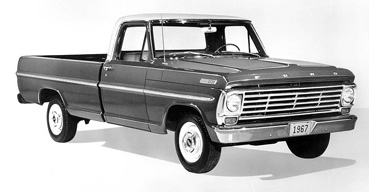 1967
was the first year of the 'bumpside' body style, used from
'67 through '72 and was a major redesign of almost all
aspects of the truck from the previous model year. While the
suspension design was largely carried over from 1966, the
body was all new. 1967
was the first year of the 'bumpside' body style, used from
'67 through '72 and was a major redesign of almost all
aspects of the truck from the previous model year. While the
suspension design was largely carried over from 1966, the
body was all new.
However, due to increased Federal safety mandates for 1968
which required certain features for passenger safety, many
areas of the cab interior were again redesigned a year after
it's debut. This resulted in the 1967 model year cab as
being a 'bastard child' of the bumpside trucks, meaning many
things about this model year's cab was different from
subsequent '68-'72 bodies. This page will detail the many
differences between 1967 cabs vs. 1968-1972 cabs, as well as
a few notable exterior and drivetrain differences. |
IN PROGRESS...CHECK BACK FOR MORE ADDITIONS TO THIS
PAGE
| DOORS |
|
One of the most
significant differences for the 1967 model year body was to
the doors, required due to more-stringent safety
regulations. While the door shell itself was relatively
unchanged, allowing interchangeability as a complete unit
with '68-'72 cabs, there are many one-year-only features.
|
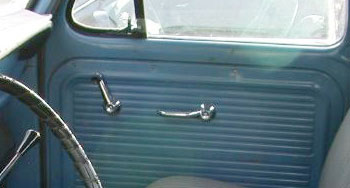
1967 Ford pickup doors have
a lever-style door release and no push-button provision for
locking the door. To lock this door, you would push down on the release
handle on the driver's side or pull up on the passenger-side handle. So
the door release/lock mechanism is '67-only. The
passenger-side armrest was optional.
|
|

The '68-'72 style had
a squeeze-type release a redesigned armrest to wrap around the
release handle for better protection. It also
included a door lock button, as well as a
redesigned window crank handle, designed to
break away in a collision. Armrests for
both doors were standard equipment.
|
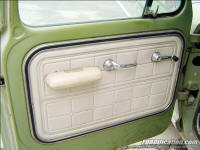 |
|
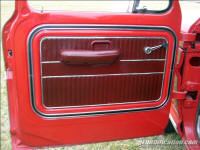 |
|
All glass,
weatherstrips and division bars remained the
same and are interchangeable.
|
|
 |
The inner door
structure was redesigned to accommodate the new door release
hardware and armrests, and the inner (steel or upholstered)
door panel was obviously changed to accommodate this. |
| |
|
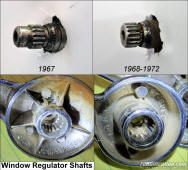 |
The 1967 window regulators
had an longer nub on the end of the regulator shaft, and the
matching regulator crank handle had a deeper well to
accommodate the nub. In '68 the regulator and crank handle
was redesigned to tuck closer to the door panel by removing
the nub and making the crank handles thinner. This was an
effort to reduce cabin intrusion and possible injuries
during a crash.
It should be noted that
the '67 and '68-'72 regulators are fully interchangeable.
While it's suggested that you keep the crank handle matched
to the regulator, the two will interchange as well, though
putting the '68-'72 handle on the '67 regulator won't allow
full spline engagement, which could lead to premature
failure. |
| |
|
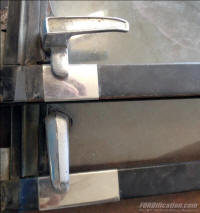 |

Vent (wing) window handles
The vent window release handles were redesigned to eliminate
sharp edges which could injure an occupant in a collision
and the scuff plate lengthened accordingly. The vent window
assembly is interchangeable as a complete unit with '68-'72
doors. |
| OTHER
IN-CAB DIFFERENCES |
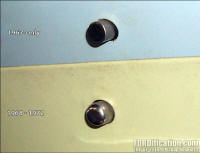 |
Glovebox door release button
In an attempt to minimize passenger injury in the event of a
collision, the 1968-1972 glovebox door release button was
rounded off, eliminating the sharp corners of the '67
version. The glovebox door itself and the latch mechanism
are fully interchangeable. |
| |
|
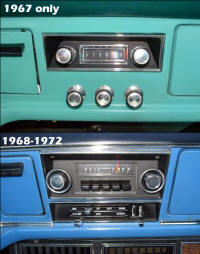 |
Radio and heater controls
1967 AM radios were
smaller than the '68-'72 versions and had no pushbuttons for station
selection. Due to it's smaller size, the dash opening was
also smaller. The larger
1968-1972 AM (and '71-'72 AM/FM) radios included pushbuttons for station selection.
Although a manual AM radio without the push buttons was available
for '68-'72, it was the same physical size and
will not fit a '67 without dash modification, nor will the matching
bezel. A radio delete (cover) plate was available for each,
but are not interchangeable due to differences in size.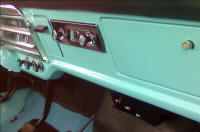
The 1967 deluxe heater controls were via a
push/pull cable and were located immediately below the
radio. 1967 trucks with the Economy heater had a single
control located by the ignition switch, and would not have
the three controls pictured here...the area beneath the
radio would be blank (pictured at right).
The '68-'72 heater controls were a slider
design to minimize cab intrusion and would also control
factory-installed A/C, if so equipped. |
| |
|
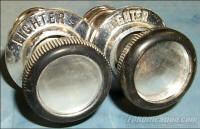
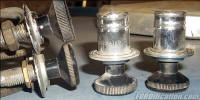 |
Dash control
knobs
The dash
knobs and bezels differ slightly when comparing the '67 versions with
'68 and later versions.In the top pic, you can see the font used on the two lighter bezels is similar, but
the '67 version on the left has a thinner font style. The '70 lighter on
the right has a much bolder font style, plus the silver button center is
recessed just a bit more.
In the bottom pic,
you can see another comparison. On the left are two choke cable
assemblies. The top version is a '67 and the '68 version on the bottom.
Note the differences in knob thickness and edge details, which is also
obvious in the side view of the two cigarette lighters. Also note the
differences in thread pitch of the choke cables, the different style
retaining nuts and the locating stud on the '68 bezel. |
| |
|
|
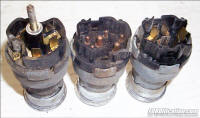 |
Ignition switch
The 1967 ignition switch on the left in this shot and is
another one-year-only item. It utilized a single hot stud
which protruded through the push-on connector, which in turn
was held on with a small nut. In the middle is an example of
a '68-'70 ignition switch, in which the harness connector
was pushed onto bullet-style connections. The '71-'72
version on the right, introduced in mid-'70, utilized a
similar style but used spade-type connectors. |
| |
|
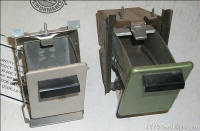
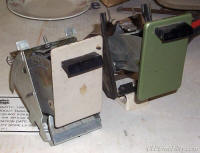 |
Ashtray
The ashtray
receiver from a '67 pickup is attached to the dash with one center-mounted screw on
top and two side screws (one screw along each side). The '68-'72 ashtray
receiver
is held on by 2 screws each on top and bottom and has a ball-bearing track
on each side. The handles of each are also slightly different. The ashtray
assemblies are not interchangeable.
Pictured at left: A white '67 ashtray vs. a green '68-'72
ashtray. |
| |
|
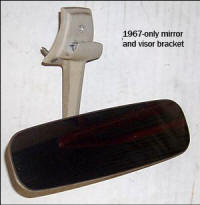 |
Rearview mirror
The '67-only in-cab rearview mirror attached to the top of
the window frame with screws and was available in chrome
(optional). The '68-'72 models had mirrors which were glued
to the top of the windshield glass. |
| |
|

 |
Parking brake mechanism
Shown in
these pictures are comparisons of the parking brake assemblies. On the
left in each picture is the '67 version, with one from a '68 on
the right in each picture. While structurally different, they do
interchange as an assembly. |
| |
|
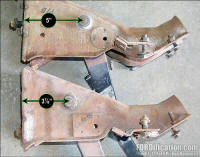 |
Clutch/brake
pedal hanger assembly
The hanger bracket under the dash is another one of
those strange '67-only pieces. As you can see at left,
the '67 (bottom) pedals' pivot point is 3⅞ inches inches
from the firewall to the middle of the pivot pin, whereas
the '68-'72 assembly (top) is 5 inches from the firewall.
This also means the master cylinder or brake booster pushrod
for the '67s had to be longer. While the hanger assembly is
interchangeable as a complete unit, it must be mated with a
correct matching brake booster or master cylinder. For more
information on this, visit
Comparing Clutch/Brake
Pedals and Brackets. |
|
|
|
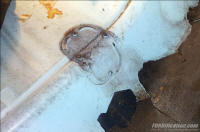 |
Transmission tunnel adjustment hole cover
While all '67-'72 trucks have an indention in
the low-hump transmission tunnel cover for a
small cover plate, only '67s have the hole
punched out and the small cover attached with
four screws. This was an access hole for
adjusting the rear band on an FMX transmission,
using the adjusting screw on the upper
right-hand side of the transmission case.
Similar-era Ford cars also had this access
hole/cover in the floorpan.
At right: the Ford truck shop
manual shows how the hole is used to adjust the
transmission band. |
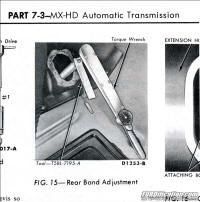 |
| 1967
is also the only year Ford didn't install a
taller bolt-on transmission hump cover when a
truck was equipped with an automatic
transmission, since this was the last year of
the smaller FMX automatic transmissions (still
verifying). |
|
|
|
|
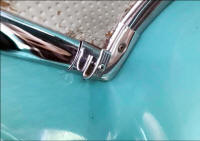 |
Garment hook
The '67-only coat hook (left) was chrome-plated and mounted
to the headliner trim. From '68-on, the hook was plastic
with a thin rubber cover and attached to the rear cab wall
(right). |
 |
| EXTERNAL
DIFFERENCES |
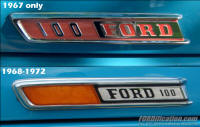 |
Hood
side emblem
The 1968-1972 hood emblems were redesigned to incorporate a
built-in reflector. |
| |
|
 |
Cowl
lacing
The cowl lacing for the hood, located on the upper firewall
inside the engine compartment, was about the only difference
that wasn't specifically safety-related. The '67 cab had the
cowl lacing mounted lower on the firewall with round holes than subsequent
model years, which used oblong slots. |
|
|
|
 |
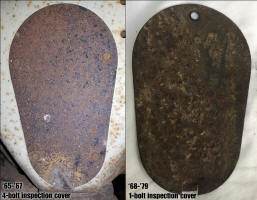 Front cab mount inspection plate Front cab mount inspection plate
The front cab mounts on 1967 models used a 4-bolt inspection
plate, while '68-'72 trucks used an inspection plate with a
bottom locating tab and attached with a single bolt on top
(shown at right). This 1-bolt plate was used up through 1979
on all F100/350 trucks.
Interestingly, although the covers are different (4-bolt vs.
1-bolt), C5TZ-81111B80-A is shown as the only part number
for this item in the the '65-'72 (1979 Final Edition) MPC
and individual-year MPCs from 1965 thru 1979. |
|
|
|
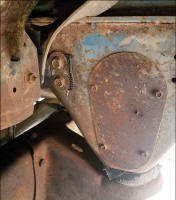 |
...and as
long as we're discussing the cab mounts, notice how the
rubber isolator that extends from the inner fender to the
cab mount is attached with two bolts at the cab mount on a
'67, whereas the later trucks just use one there. |
|
|
|
|


|
Hood braces
The
hood's outer skin is identical on all '67-'72 F100 thru F350
trucks. However, the inner bracing is a little different on the
'67s. The '68-up hoods had an additional hole that the '67s
didn't have (shown at upper left). In addition, the side bracing
is very slightly different (shown at lower left), with the
'68-up hoods having additional supports.
As a side note, '67 and some early-'68 hoods had a small hood support
bracket with a rubber pad which bolted to the firewall and
supported the rear part of the hood (shown upper right).
Late-'68/later hoods didn't have this bracket, but used an
additional rubber bumper at the trailing edge of the
hood (shown at lower right). |

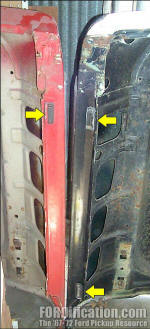 |
|
| |
|
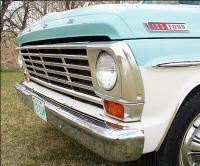 |
Radiator grille
The front grille is '67-only, but not related to safety.
Each model year truck during the '67-'72 era had a different
grille and was simply a styling change during each model
year. |
| |
|
 |
Aluminum side trim
Aluminum beltline trim
(referred to as 'bright body side moldings' by the factory) was
optional an all models, including the Ranger, though the trim was standard for trucks
with a deluxe two-tone paint job and not available on base-model trucks
except with the two-tone paint. The '67 (and some early
'68s) narrow side trim was 1-1/4" wide, compared to the
wider (1-1/2") trim used on '68-'72 trucks. This trim was also used on '68 trucks
up to serial
number C56,001, so it's not specifically a '67-only item. |
|
|
|
|
Tailgate trim |
1967 styleside tailgates were not available
with a center filler panel. The tailgates on standard-cab
trucks were either plain (with no chrome trim) or, if with a
two-tone paint job, they had a single chrome strip along the
base of the tailgate, where the two colors met. Ranger
tailgates were equipped with stainless perimeter trim and
chrome tailgate release handles.
1968-1969 tailgate trim was identical to the '67s, except
that in addition to the perimeter trim, the Ranger models
also got the argent filler panel (C8TZ-99425A34-A). |

Single chrome strip with two-tone paint |

'67 full perimeter trim |

'68-'69 Ranger - full perimeter trim with
small argent filler panel (also used on early-'70 models) |
|
| |
|
| Rear
reflectors |
| 1967 was the only model year
in which rear reflectors were not mandated. Each subsequent
model year had slight variations and placements for the
reflectors. |
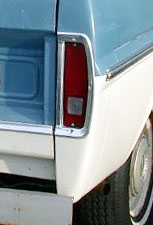
1967
No reflectors |
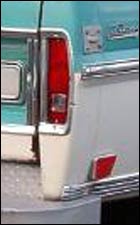
1968
Side reflector, no
rear reflector |
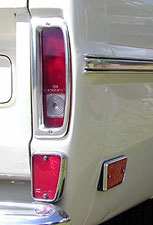
1969
Both side and
rear reflectors |
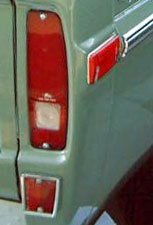
1970-1972
Rear reflector and lighted
side marker light |
|
|
| |
|
Underdash wiring harness
While this should be assumed without saying, for the sake of
being complete it should be mentioned that the 1967 wiring
harness is a one-year-only item, due to the unique ignition
switch and heater control wiring. |
| |
|
 |
Engine - 352 cid
While the 352 cid V8 engine was used in some previous model
years, 1967 was the last year it was installed in a Ford
pickup. Therefore, while not '67 specific, it's included in
this list as the only year the 352 was installed in a
'67-'72 Ford pickup. |
|
|
|
|
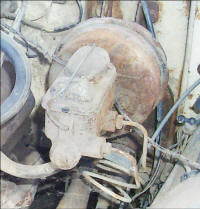
1967-only 6 3/4" brake booster |
Brakes
The front and rear brakes shoes for 1967 F100s were slightly
narrower than subsequent years. In fact, Ford's 1968 sales
literature touted the new bigger brakes with "...over 45%
more lining area..." over the 1967 model year.
1967 F100's 11" x 2" (front) and 11" x 1
3/4" (rear) brakes increased to 11 1/32" x 3" (front) and 2
1/4" (rear) for 1968. Optional power brakes in 1967
consisted of a 6 3/4" vacuum booster, which was increased to
a 9" booster for 1968. |
|
|
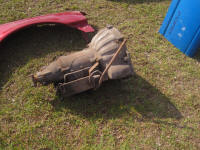 |
Heat exchanger
The transmission cooler was actually a heat exchanger, which
transferred heat from the transmission to the engine
coolant, where it would be cooled by the radiator.
Starting in
'68, the transmission cooler was integrated with the
radiator. |
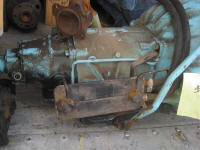 |
|
|
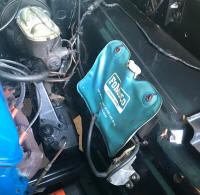 |
Windshield washer bag
1967 was the last year a flexible vinyl bag was used to
store windshield washer fluid. A remote-mounted pump on the
inner fender pumped the fluid up to the windshield.
Starting in 1968, the bag
was replaced with a hard plastic reservoir with an
integrated pump and mounted in the same location. |
|
|
 |

Want to link to
this site? Please save this banner to your hard drive to place on your
webpage.
The correct link to use is
http://www.fordification.com
|